Hospitality and Tourism Distribution: Analysis and Strategies
VerifiedAdded on 2021/05/31
|13
|3119
|52
Report
AI Summary
This report provides a comprehensive analysis of distribution channels within the hospitality and tourism sector, specifically focusing on the Australian market. It explores distribution theories, including price discrimination, and examines the various channels through which products and services are made available, such as call centers and travel agencies. The report also delves into the integration of technological applications to optimize operational effectiveness, highlighting the use of online platforms, social media, and mobile technologies for booking and marketing. Furthermore, it presents a SWOT analysis of the distribution strategies employed by hotels like the Brighton Savoy Hotel, discussing strengths, weaknesses, opportunities, and threats. Finally, the report addresses emerging channels of distribution and the impact of technology on enhancing customer experiences from reservation to checkout, offering valuable insights into the evolving landscape of the hospitality and tourism industry.
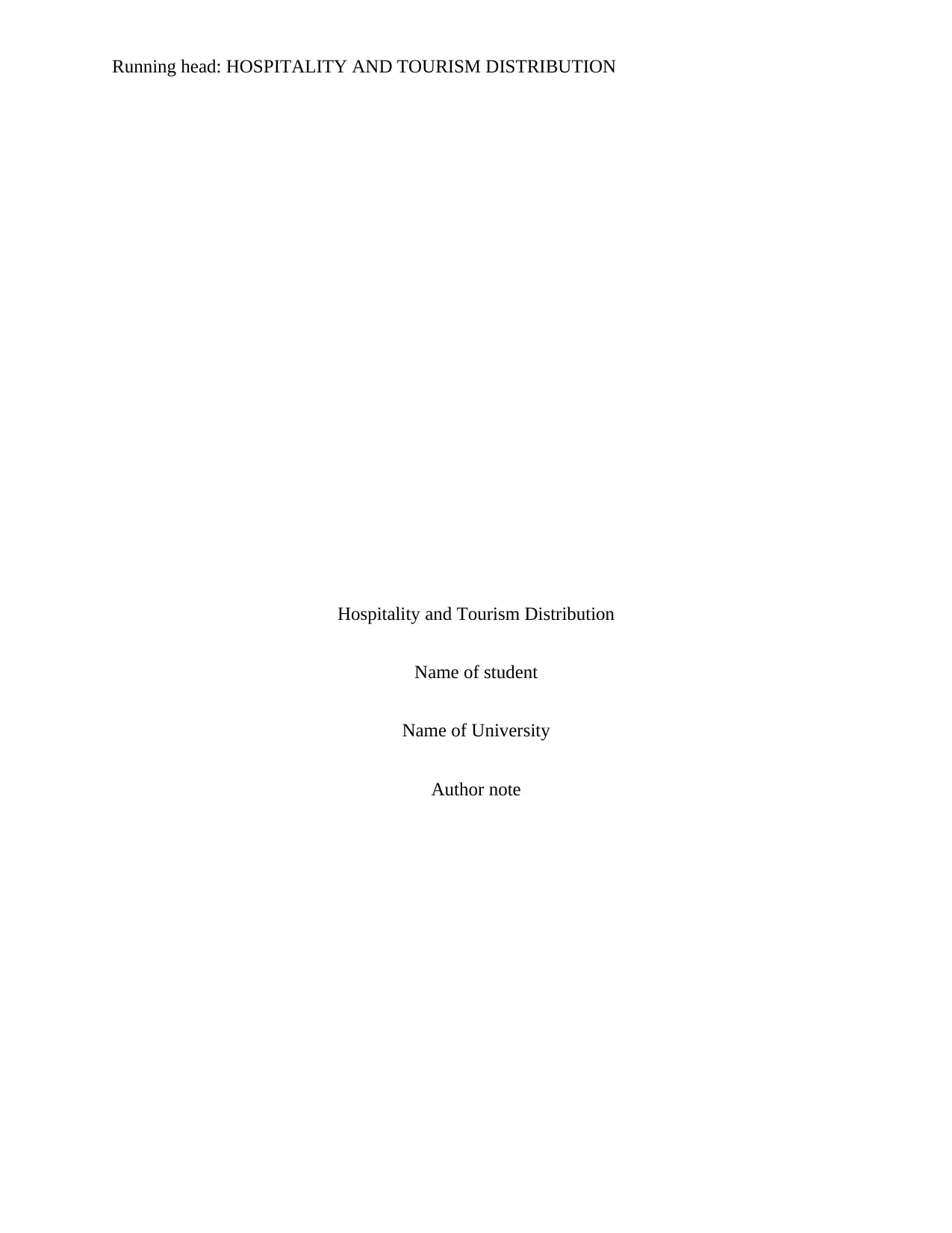
Running head: HOSPITALITY AND TOURISM DISTRIBUTION
Hospitality and Tourism Distribution
Name of student
Name of University
Author note
Hospitality and Tourism Distribution
Name of student
Name of University
Author note
Paraphrase This Document
Need a fresh take? Get an instant paraphrase of this document with our AI Paraphraser
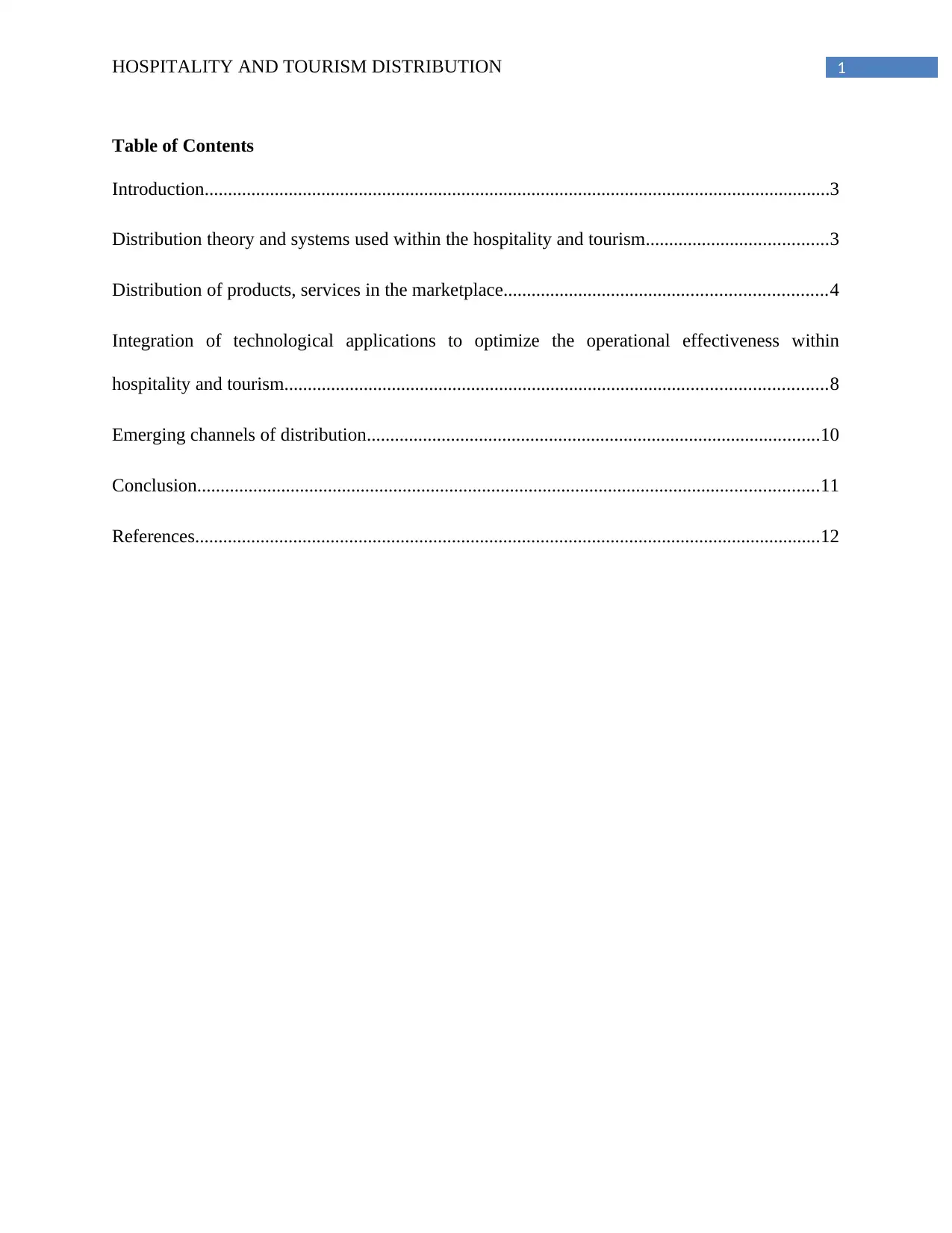
1HOSPITALITY AND TOURISM DISTRIBUTION
Table of Contents
Introduction......................................................................................................................................3
Distribution theory and systems used within the hospitality and tourism.......................................3
Distribution of products, services in the marketplace.....................................................................4
Integration of technological applications to optimize the operational effectiveness within
hospitality and tourism....................................................................................................................8
Emerging channels of distribution.................................................................................................10
Conclusion.....................................................................................................................................11
References......................................................................................................................................12
Table of Contents
Introduction......................................................................................................................................3
Distribution theory and systems used within the hospitality and tourism.......................................3
Distribution of products, services in the marketplace.....................................................................4
Integration of technological applications to optimize the operational effectiveness within
hospitality and tourism....................................................................................................................8
Emerging channels of distribution.................................................................................................10
Conclusion.....................................................................................................................................11
References......................................................................................................................................12
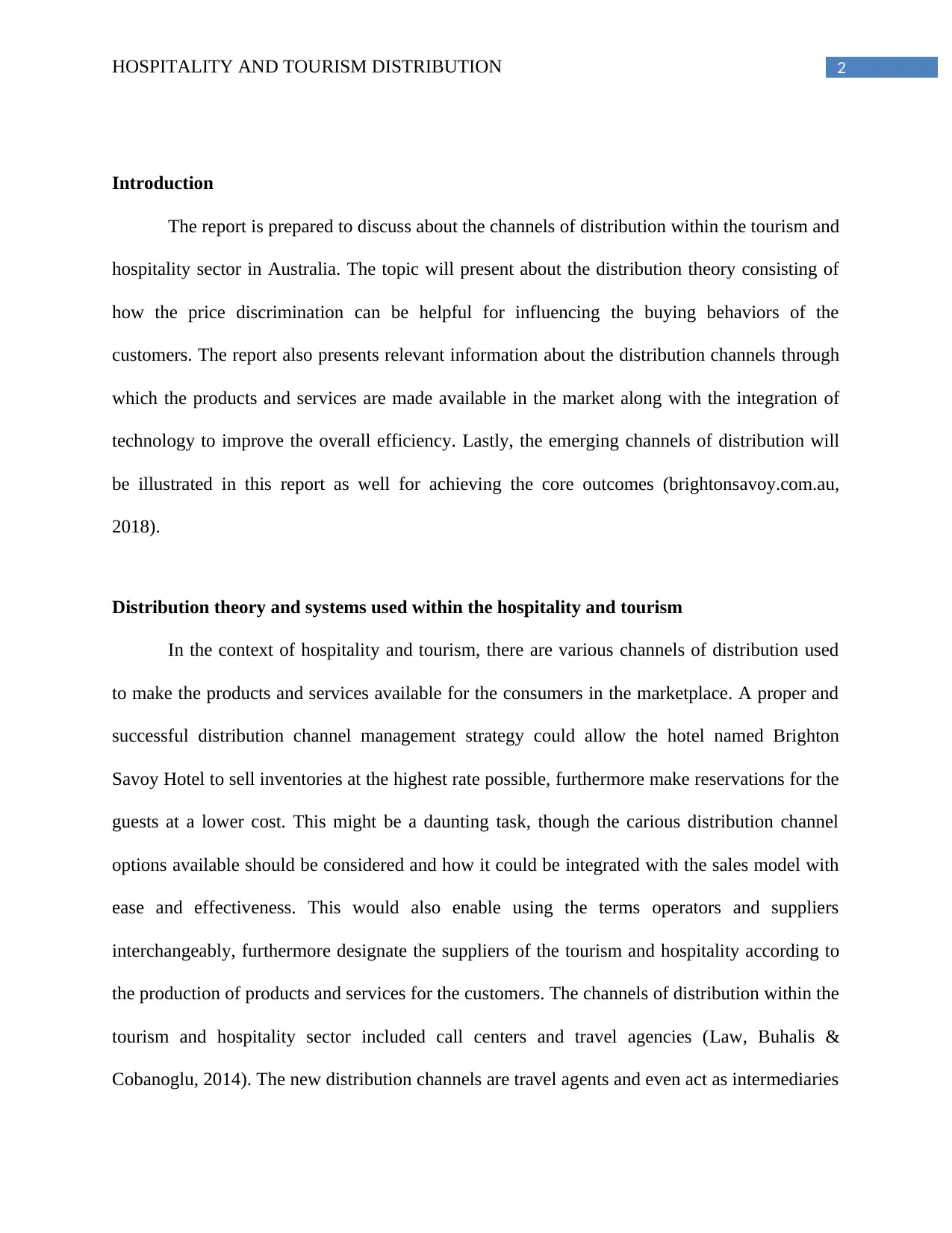
2HOSPITALITY AND TOURISM DISTRIBUTION
Introduction
The report is prepared to discuss about the channels of distribution within the tourism and
hospitality sector in Australia. The topic will present about the distribution theory consisting of
how the price discrimination can be helpful for influencing the buying behaviors of the
customers. The report also presents relevant information about the distribution channels through
which the products and services are made available in the market along with the integration of
technology to improve the overall efficiency. Lastly, the emerging channels of distribution will
be illustrated in this report as well for achieving the core outcomes (brightonsavoy.com.au,
2018).
Distribution theory and systems used within the hospitality and tourism
In the context of hospitality and tourism, there are various channels of distribution used
to make the products and services available for the consumers in the marketplace. A proper and
successful distribution channel management strategy could allow the hotel named Brighton
Savoy Hotel to sell inventories at the highest rate possible, furthermore make reservations for the
guests at a lower cost. This might be a daunting task, though the carious distribution channel
options available should be considered and how it could be integrated with the sales model with
ease and effectiveness. This would also enable using the terms operators and suppliers
interchangeably, furthermore designate the suppliers of the tourism and hospitality according to
the production of products and services for the customers. The channels of distribution within the
tourism and hospitality sector included call centers and travel agencies (Law, Buhalis &
Cobanoglu, 2014). The new distribution channels are travel agents and even act as intermediaries
Introduction
The report is prepared to discuss about the channels of distribution within the tourism and
hospitality sector in Australia. The topic will present about the distribution theory consisting of
how the price discrimination can be helpful for influencing the buying behaviors of the
customers. The report also presents relevant information about the distribution channels through
which the products and services are made available in the market along with the integration of
technology to improve the overall efficiency. Lastly, the emerging channels of distribution will
be illustrated in this report as well for achieving the core outcomes (brightonsavoy.com.au,
2018).
Distribution theory and systems used within the hospitality and tourism
In the context of hospitality and tourism, there are various channels of distribution used
to make the products and services available for the consumers in the marketplace. A proper and
successful distribution channel management strategy could allow the hotel named Brighton
Savoy Hotel to sell inventories at the highest rate possible, furthermore make reservations for the
guests at a lower cost. This might be a daunting task, though the carious distribution channel
options available should be considered and how it could be integrated with the sales model with
ease and effectiveness. This would also enable using the terms operators and suppliers
interchangeably, furthermore designate the suppliers of the tourism and hospitality according to
the production of products and services for the customers. The channels of distribution within the
tourism and hospitality sector included call centers and travel agencies (Law, Buhalis &
Cobanoglu, 2014). The new distribution channels are travel agents and even act as intermediaries
⊘ This is a preview!⊘
Do you want full access?
Subscribe today to unlock all pages.

Trusted by 1+ million students worldwide
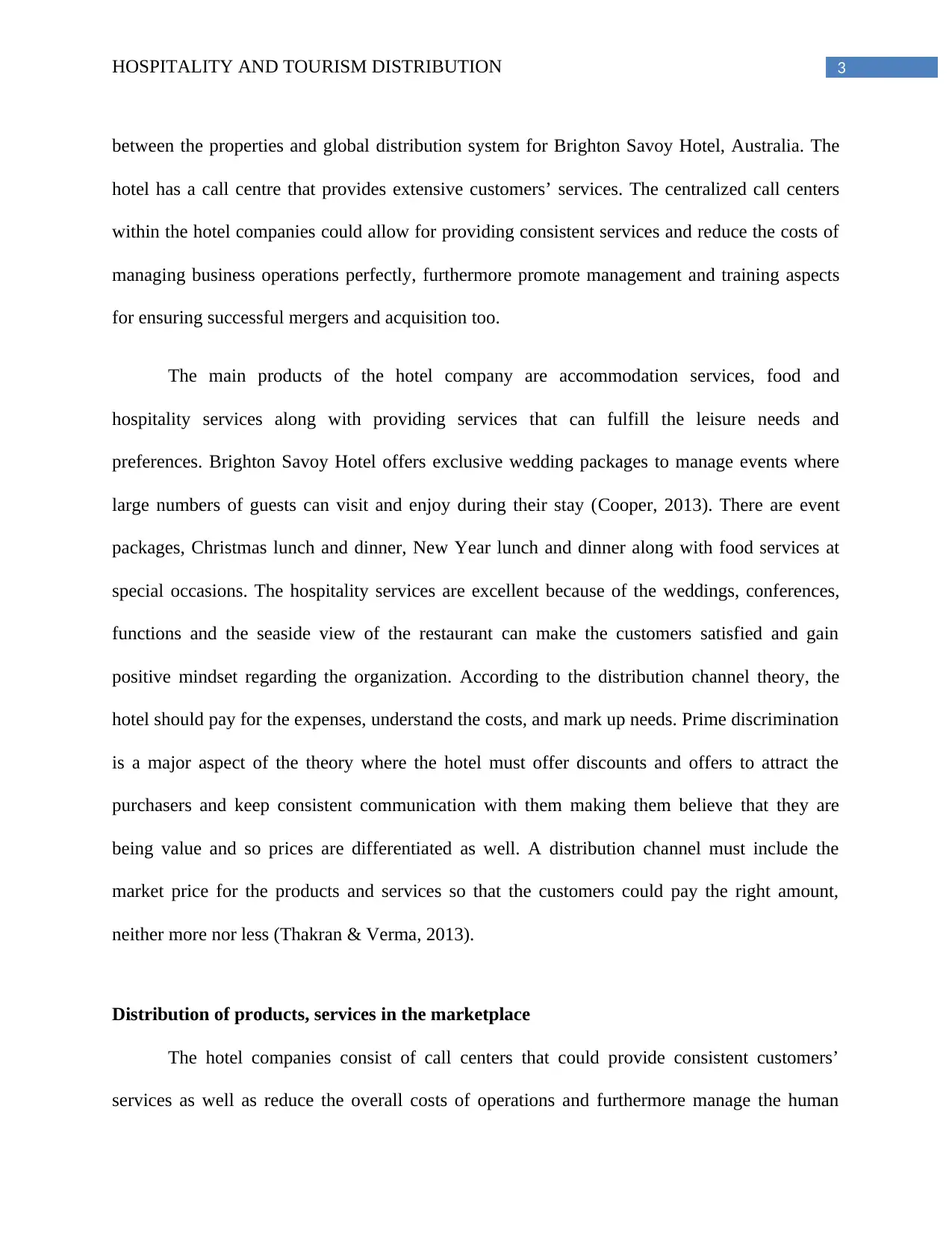
3HOSPITALITY AND TOURISM DISTRIBUTION
between the properties and global distribution system for Brighton Savoy Hotel, Australia. The
hotel has a call centre that provides extensive customers’ services. The centralized call centers
within the hotel companies could allow for providing consistent services and reduce the costs of
managing business operations perfectly, furthermore promote management and training aspects
for ensuring successful mergers and acquisition too.
The main products of the hotel company are accommodation services, food and
hospitality services along with providing services that can fulfill the leisure needs and
preferences. Brighton Savoy Hotel offers exclusive wedding packages to manage events where
large numbers of guests can visit and enjoy during their stay (Cooper, 2013). There are event
packages, Christmas lunch and dinner, New Year lunch and dinner along with food services at
special occasions. The hospitality services are excellent because of the weddings, conferences,
functions and the seaside view of the restaurant can make the customers satisfied and gain
positive mindset regarding the organization. According to the distribution channel theory, the
hotel should pay for the expenses, understand the costs, and mark up needs. Prime discrimination
is a major aspect of the theory where the hotel must offer discounts and offers to attract the
purchasers and keep consistent communication with them making them believe that they are
being value and so prices are differentiated as well. A distribution channel must include the
market price for the products and services so that the customers could pay the right amount,
neither more nor less (Thakran & Verma, 2013).
Distribution of products, services in the marketplace
The hotel companies consist of call centers that could provide consistent customers’
services as well as reduce the overall costs of operations and furthermore manage the human
between the properties and global distribution system for Brighton Savoy Hotel, Australia. The
hotel has a call centre that provides extensive customers’ services. The centralized call centers
within the hotel companies could allow for providing consistent services and reduce the costs of
managing business operations perfectly, furthermore promote management and training aspects
for ensuring successful mergers and acquisition too.
The main products of the hotel company are accommodation services, food and
hospitality services along with providing services that can fulfill the leisure needs and
preferences. Brighton Savoy Hotel offers exclusive wedding packages to manage events where
large numbers of guests can visit and enjoy during their stay (Cooper, 2013). There are event
packages, Christmas lunch and dinner, New Year lunch and dinner along with food services at
special occasions. The hospitality services are excellent because of the weddings, conferences,
functions and the seaside view of the restaurant can make the customers satisfied and gain
positive mindset regarding the organization. According to the distribution channel theory, the
hotel should pay for the expenses, understand the costs, and mark up needs. Prime discrimination
is a major aspect of the theory where the hotel must offer discounts and offers to attract the
purchasers and keep consistent communication with them making them believe that they are
being value and so prices are differentiated as well. A distribution channel must include the
market price for the products and services so that the customers could pay the right amount,
neither more nor less (Thakran & Verma, 2013).
Distribution of products, services in the marketplace
The hotel companies consist of call centers that could provide consistent customers’
services as well as reduce the overall costs of operations and furthermore manage the human
Paraphrase This Document
Need a fresh take? Get an instant paraphrase of this document with our AI Paraphraser
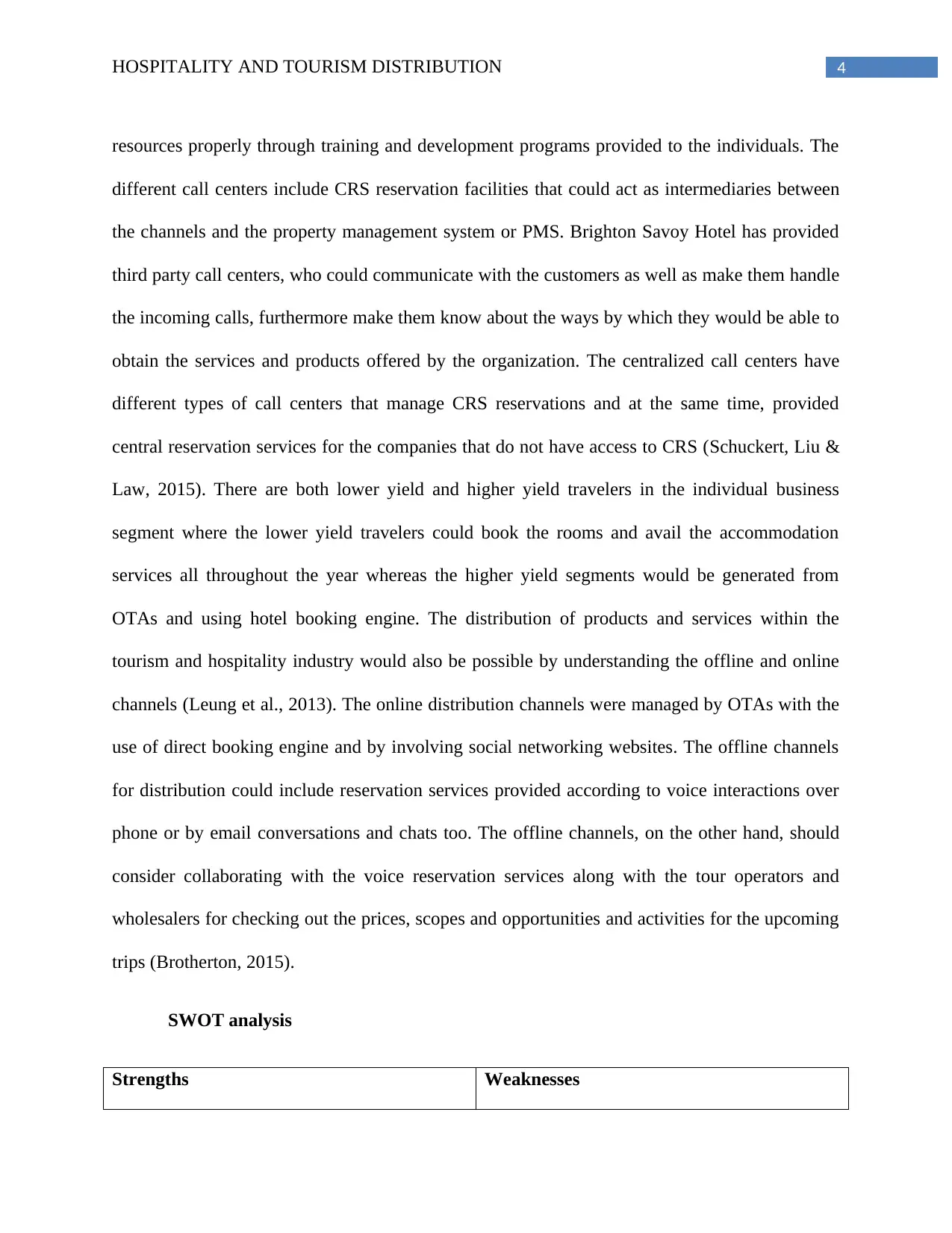
4HOSPITALITY AND TOURISM DISTRIBUTION
resources properly through training and development programs provided to the individuals. The
different call centers include CRS reservation facilities that could act as intermediaries between
the channels and the property management system or PMS. Brighton Savoy Hotel has provided
third party call centers, who could communicate with the customers as well as make them handle
the incoming calls, furthermore make them know about the ways by which they would be able to
obtain the services and products offered by the organization. The centralized call centers have
different types of call centers that manage CRS reservations and at the same time, provided
central reservation services for the companies that do not have access to CRS (Schuckert, Liu &
Law, 2015). There are both lower yield and higher yield travelers in the individual business
segment where the lower yield travelers could book the rooms and avail the accommodation
services all throughout the year whereas the higher yield segments would be generated from
OTAs and using hotel booking engine. The distribution of products and services within the
tourism and hospitality industry would also be possible by understanding the offline and online
channels (Leung et al., 2013). The online distribution channels were managed by OTAs with the
use of direct booking engine and by involving social networking websites. The offline channels
for distribution could include reservation services provided according to voice interactions over
phone or by email conversations and chats too. The offline channels, on the other hand, should
consider collaborating with the voice reservation services along with the tour operators and
wholesalers for checking out the prices, scopes and opportunities and activities for the upcoming
trips (Brotherton, 2015).
SWOT analysis
Strengths Weaknesses
resources properly through training and development programs provided to the individuals. The
different call centers include CRS reservation facilities that could act as intermediaries between
the channels and the property management system or PMS. Brighton Savoy Hotel has provided
third party call centers, who could communicate with the customers as well as make them handle
the incoming calls, furthermore make them know about the ways by which they would be able to
obtain the services and products offered by the organization. The centralized call centers have
different types of call centers that manage CRS reservations and at the same time, provided
central reservation services for the companies that do not have access to CRS (Schuckert, Liu &
Law, 2015). There are both lower yield and higher yield travelers in the individual business
segment where the lower yield travelers could book the rooms and avail the accommodation
services all throughout the year whereas the higher yield segments would be generated from
OTAs and using hotel booking engine. The distribution of products and services within the
tourism and hospitality industry would also be possible by understanding the offline and online
channels (Leung et al., 2013). The online distribution channels were managed by OTAs with the
use of direct booking engine and by involving social networking websites. The offline channels
for distribution could include reservation services provided according to voice interactions over
phone or by email conversations and chats too. The offline channels, on the other hand, should
consider collaborating with the voice reservation services along with the tour operators and
wholesalers for checking out the prices, scopes and opportunities and activities for the upcoming
trips (Brotherton, 2015).
SWOT analysis
Strengths Weaknesses
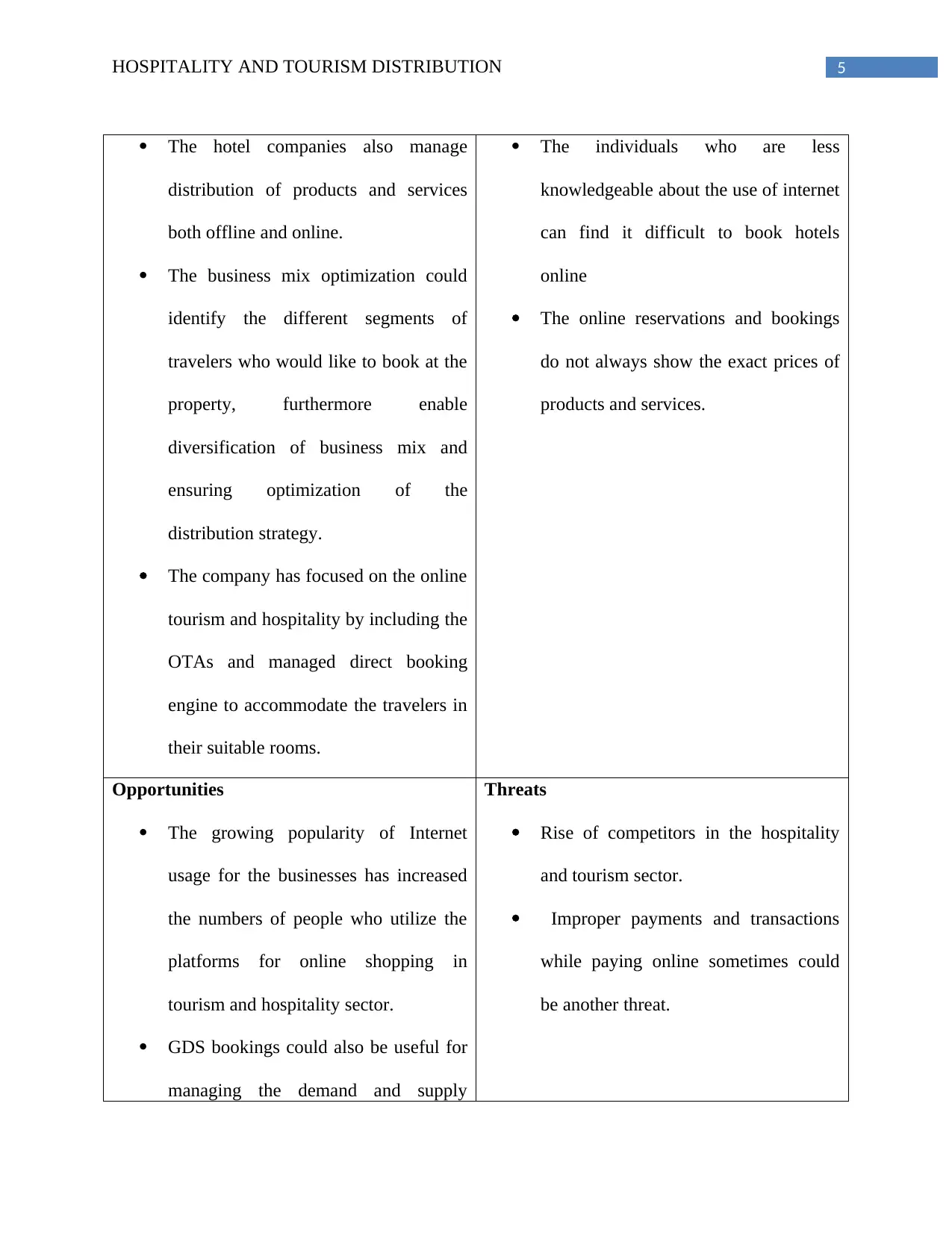
5HOSPITALITY AND TOURISM DISTRIBUTION
The hotel companies also manage
distribution of products and services
both offline and online.
The business mix optimization could
identify the different segments of
travelers who would like to book at the
property, furthermore enable
diversification of business mix and
ensuring optimization of the
distribution strategy.
The company has focused on the online
tourism and hospitality by including the
OTAs and managed direct booking
engine to accommodate the travelers in
their suitable rooms.
The individuals who are less
knowledgeable about the use of internet
can find it difficult to book hotels
online
The online reservations and bookings
do not always show the exact prices of
products and services.
Opportunities
The growing popularity of Internet
usage for the businesses has increased
the numbers of people who utilize the
platforms for online shopping in
tourism and hospitality sector.
GDS bookings could also be useful for
managing the demand and supply
Threats
Rise of competitors in the hospitality
and tourism sector.
Improper payments and transactions
while paying online sometimes could
be another threat.
The hotel companies also manage
distribution of products and services
both offline and online.
The business mix optimization could
identify the different segments of
travelers who would like to book at the
property, furthermore enable
diversification of business mix and
ensuring optimization of the
distribution strategy.
The company has focused on the online
tourism and hospitality by including the
OTAs and managed direct booking
engine to accommodate the travelers in
their suitable rooms.
The individuals who are less
knowledgeable about the use of internet
can find it difficult to book hotels
online
The online reservations and bookings
do not always show the exact prices of
products and services.
Opportunities
The growing popularity of Internet
usage for the businesses has increased
the numbers of people who utilize the
platforms for online shopping in
tourism and hospitality sector.
GDS bookings could also be useful for
managing the demand and supply
Threats
Rise of competitors in the hospitality
and tourism sector.
Improper payments and transactions
while paying online sometimes could
be another threat.
⊘ This is a preview!⊘
Do you want full access?
Subscribe today to unlock all pages.

Trusted by 1+ million students worldwide
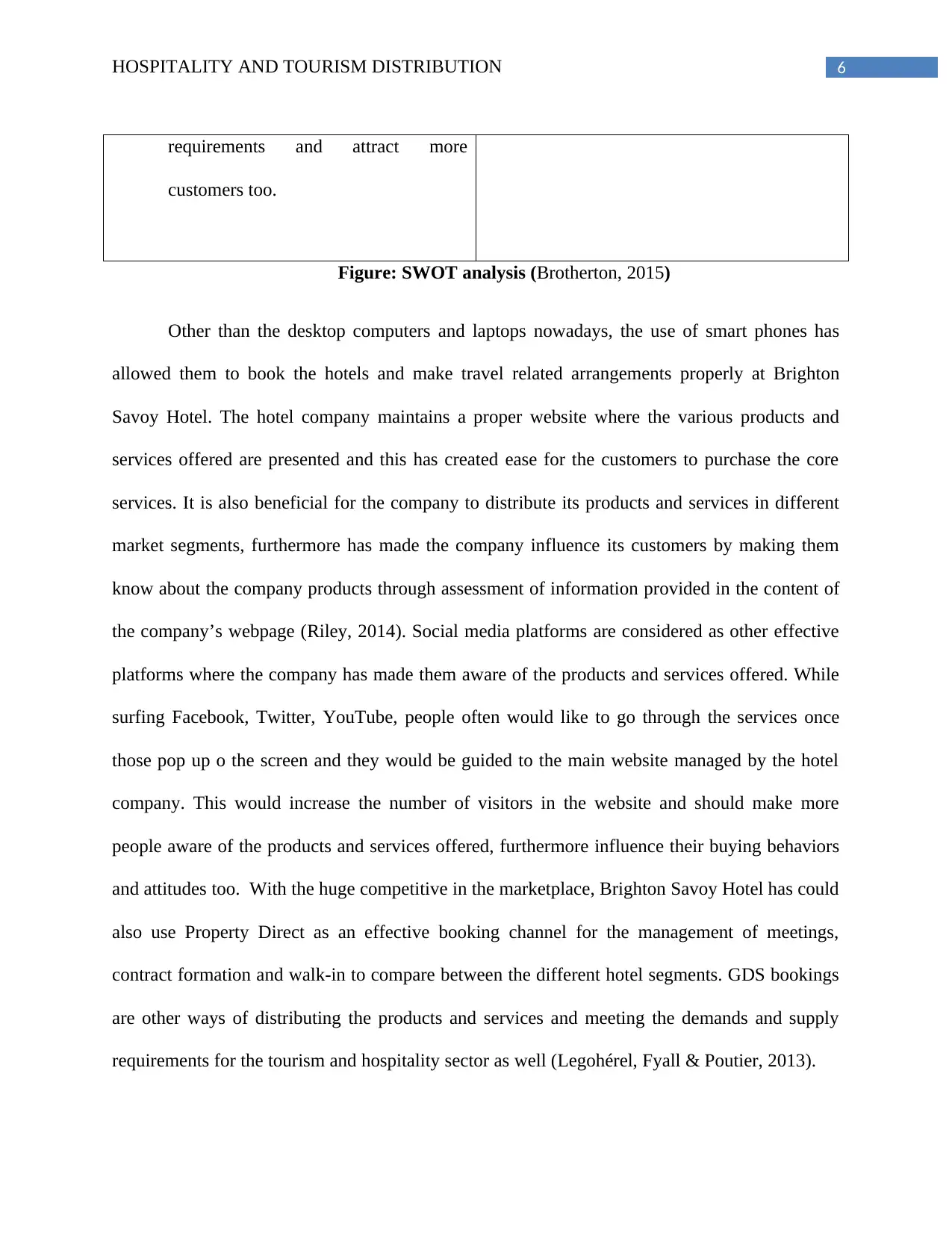
6HOSPITALITY AND TOURISM DISTRIBUTION
requirements and attract more
customers too.
Figure: SWOT analysis (Brotherton, 2015)
Other than the desktop computers and laptops nowadays, the use of smart phones has
allowed them to book the hotels and make travel related arrangements properly at Brighton
Savoy Hotel. The hotel company maintains a proper website where the various products and
services offered are presented and this has created ease for the customers to purchase the core
services. It is also beneficial for the company to distribute its products and services in different
market segments, furthermore has made the company influence its customers by making them
know about the company products through assessment of information provided in the content of
the company’s webpage (Riley, 2014). Social media platforms are considered as other effective
platforms where the company has made them aware of the products and services offered. While
surfing Facebook, Twitter, YouTube, people often would like to go through the services once
those pop up o the screen and they would be guided to the main website managed by the hotel
company. This would increase the number of visitors in the website and should make more
people aware of the products and services offered, furthermore influence their buying behaviors
and attitudes too. With the huge competitive in the marketplace, Brighton Savoy Hotel has could
also use Property Direct as an effective booking channel for the management of meetings,
contract formation and walk-in to compare between the different hotel segments. GDS bookings
are other ways of distributing the products and services and meeting the demands and supply
requirements for the tourism and hospitality sector as well (Legohérel, Fyall & Poutier, 2013).
requirements and attract more
customers too.
Figure: SWOT analysis (Brotherton, 2015)
Other than the desktop computers and laptops nowadays, the use of smart phones has
allowed them to book the hotels and make travel related arrangements properly at Brighton
Savoy Hotel. The hotel company maintains a proper website where the various products and
services offered are presented and this has created ease for the customers to purchase the core
services. It is also beneficial for the company to distribute its products and services in different
market segments, furthermore has made the company influence its customers by making them
know about the company products through assessment of information provided in the content of
the company’s webpage (Riley, 2014). Social media platforms are considered as other effective
platforms where the company has made them aware of the products and services offered. While
surfing Facebook, Twitter, YouTube, people often would like to go through the services once
those pop up o the screen and they would be guided to the main website managed by the hotel
company. This would increase the number of visitors in the website and should make more
people aware of the products and services offered, furthermore influence their buying behaviors
and attitudes too. With the huge competitive in the marketplace, Brighton Savoy Hotel has could
also use Property Direct as an effective booking channel for the management of meetings,
contract formation and walk-in to compare between the different hotel segments. GDS bookings
are other ways of distributing the products and services and meeting the demands and supply
requirements for the tourism and hospitality sector as well (Legohérel, Fyall & Poutier, 2013).
Paraphrase This Document
Need a fresh take? Get an instant paraphrase of this document with our AI Paraphraser
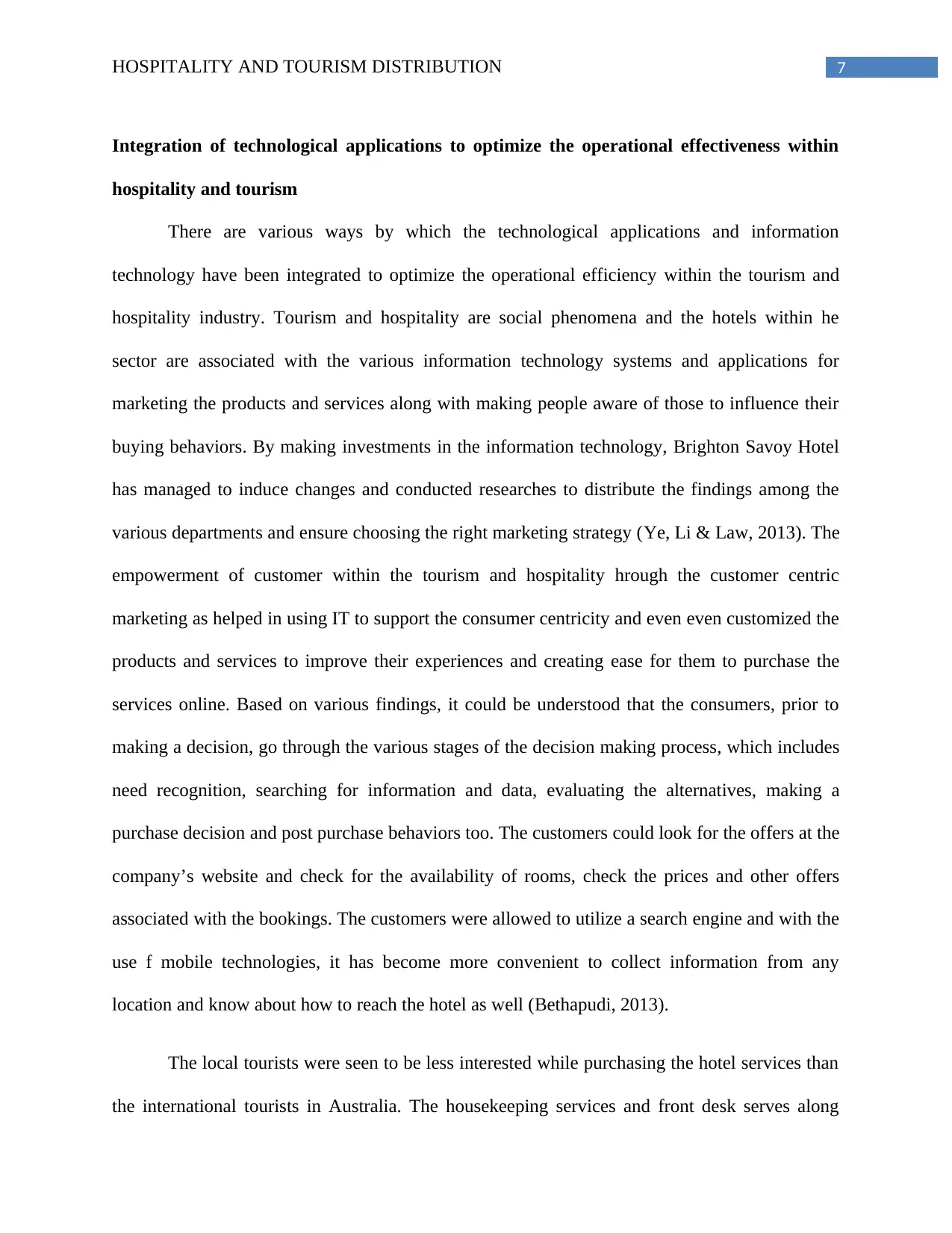
7HOSPITALITY AND TOURISM DISTRIBUTION
Integration of technological applications to optimize the operational effectiveness within
hospitality and tourism
There are various ways by which the technological applications and information
technology have been integrated to optimize the operational efficiency within the tourism and
hospitality industry. Tourism and hospitality are social phenomena and the hotels within he
sector are associated with the various information technology systems and applications for
marketing the products and services along with making people aware of those to influence their
buying behaviors. By making investments in the information technology, Brighton Savoy Hotel
has managed to induce changes and conducted researches to distribute the findings among the
various departments and ensure choosing the right marketing strategy (Ye, Li & Law, 2013). The
empowerment of customer within the tourism and hospitality hrough the customer centric
marketing as helped in using IT to support the consumer centricity and even even customized the
products and services to improve their experiences and creating ease for them to purchase the
services online. Based on various findings, it could be understood that the consumers, prior to
making a decision, go through the various stages of the decision making process, which includes
need recognition, searching for information and data, evaluating the alternatives, making a
purchase decision and post purchase behaviors too. The customers could look for the offers at the
company’s website and check for the availability of rooms, check the prices and other offers
associated with the bookings. The customers were allowed to utilize a search engine and with the
use f mobile technologies, it has become more convenient to collect information from any
location and know about how to reach the hotel as well (Bethapudi, 2013).
The local tourists were seen to be less interested while purchasing the hotel services than
the international tourists in Australia. The housekeeping services and front desk serves along
Integration of technological applications to optimize the operational effectiveness within
hospitality and tourism
There are various ways by which the technological applications and information
technology have been integrated to optimize the operational efficiency within the tourism and
hospitality industry. Tourism and hospitality are social phenomena and the hotels within he
sector are associated with the various information technology systems and applications for
marketing the products and services along with making people aware of those to influence their
buying behaviors. By making investments in the information technology, Brighton Savoy Hotel
has managed to induce changes and conducted researches to distribute the findings among the
various departments and ensure choosing the right marketing strategy (Ye, Li & Law, 2013). The
empowerment of customer within the tourism and hospitality hrough the customer centric
marketing as helped in using IT to support the consumer centricity and even even customized the
products and services to improve their experiences and creating ease for them to purchase the
services online. Based on various findings, it could be understood that the consumers, prior to
making a decision, go through the various stages of the decision making process, which includes
need recognition, searching for information and data, evaluating the alternatives, making a
purchase decision and post purchase behaviors too. The customers could look for the offers at the
company’s website and check for the availability of rooms, check the prices and other offers
associated with the bookings. The customers were allowed to utilize a search engine and with the
use f mobile technologies, it has become more convenient to collect information from any
location and know about how to reach the hotel as well (Bethapudi, 2013).
The local tourists were seen to be less interested while purchasing the hotel services than
the international tourists in Australia. The housekeeping services and front desk serves along

8HOSPITALITY AND TOURISM DISTRIBUTION
with the sizes of rooms are considered as important factors that can contribute to the perception
of hotel standards and make the customers gain the interest to search for the hotel rooms and
then make a purchasing decision. The customers could look for the reviews and feedbacks
provided by other tourists from the company website and rely on the hotel branding strategies
while making online reservations for the rooms at Brighton Savoy Hotel, Australia (Tang, 2014).
The electronic word of mouth information and online security could make them more understand
whether their needs could be met or not. Brighton Savoy Hotel offers services for managing
events and wedding ceremonies as well, which can be booked online with the use of internet and
the extensive customers’ services have allowed remaining connected with the customers and
delivering products and services accordingly for the fulfillment of their needs and preferences.
The company’s values require excellent presentation, mutual respect, commitment and
dedication for bringing excellence (Denizci Guillet & Mohammed, 2015).
With the integration of various technological applications, it has become easy for
managing continuous communication and streamlines the experiences of the guests right from
the reservation until the checkout. The experiences start as soon as the customers visit the hotel’s
website and watching the photos of the location and knowing about what to expect. The use of
internet technologies have brought immense benefits by providing information about the
products and services online and through social media involvement. The information repositories
hold relevant amount of data and information about the customers, which can allow for
communicating with the customers afterwards and make them know about the offers, discounts
for products and additional benefits offered by the hotel. Brighton Savoy Hotel has involved the
online interfaces including Expedia and Orbitz, which not only reduces the costs of booking for
ravel businesses and also offers the client with benefits regarding additional discounts and offers
with the sizes of rooms are considered as important factors that can contribute to the perception
of hotel standards and make the customers gain the interest to search for the hotel rooms and
then make a purchasing decision. The customers could look for the reviews and feedbacks
provided by other tourists from the company website and rely on the hotel branding strategies
while making online reservations for the rooms at Brighton Savoy Hotel, Australia (Tang, 2014).
The electronic word of mouth information and online security could make them more understand
whether their needs could be met or not. Brighton Savoy Hotel offers services for managing
events and wedding ceremonies as well, which can be booked online with the use of internet and
the extensive customers’ services have allowed remaining connected with the customers and
delivering products and services accordingly for the fulfillment of their needs and preferences.
The company’s values require excellent presentation, mutual respect, commitment and
dedication for bringing excellence (Denizci Guillet & Mohammed, 2015).
With the integration of various technological applications, it has become easy for
managing continuous communication and streamlines the experiences of the guests right from
the reservation until the checkout. The experiences start as soon as the customers visit the hotel’s
website and watching the photos of the location and knowing about what to expect. The use of
internet technologies have brought immense benefits by providing information about the
products and services online and through social media involvement. The information repositories
hold relevant amount of data and information about the customers, which can allow for
communicating with the customers afterwards and make them know about the offers, discounts
for products and additional benefits offered by the hotel. Brighton Savoy Hotel has involved the
online interfaces including Expedia and Orbitz, which not only reduces the costs of booking for
ravel businesses and also offers the client with benefits regarding additional discounts and offers
⊘ This is a preview!⊘
Do you want full access?
Subscribe today to unlock all pages.

Trusted by 1+ million students worldwide
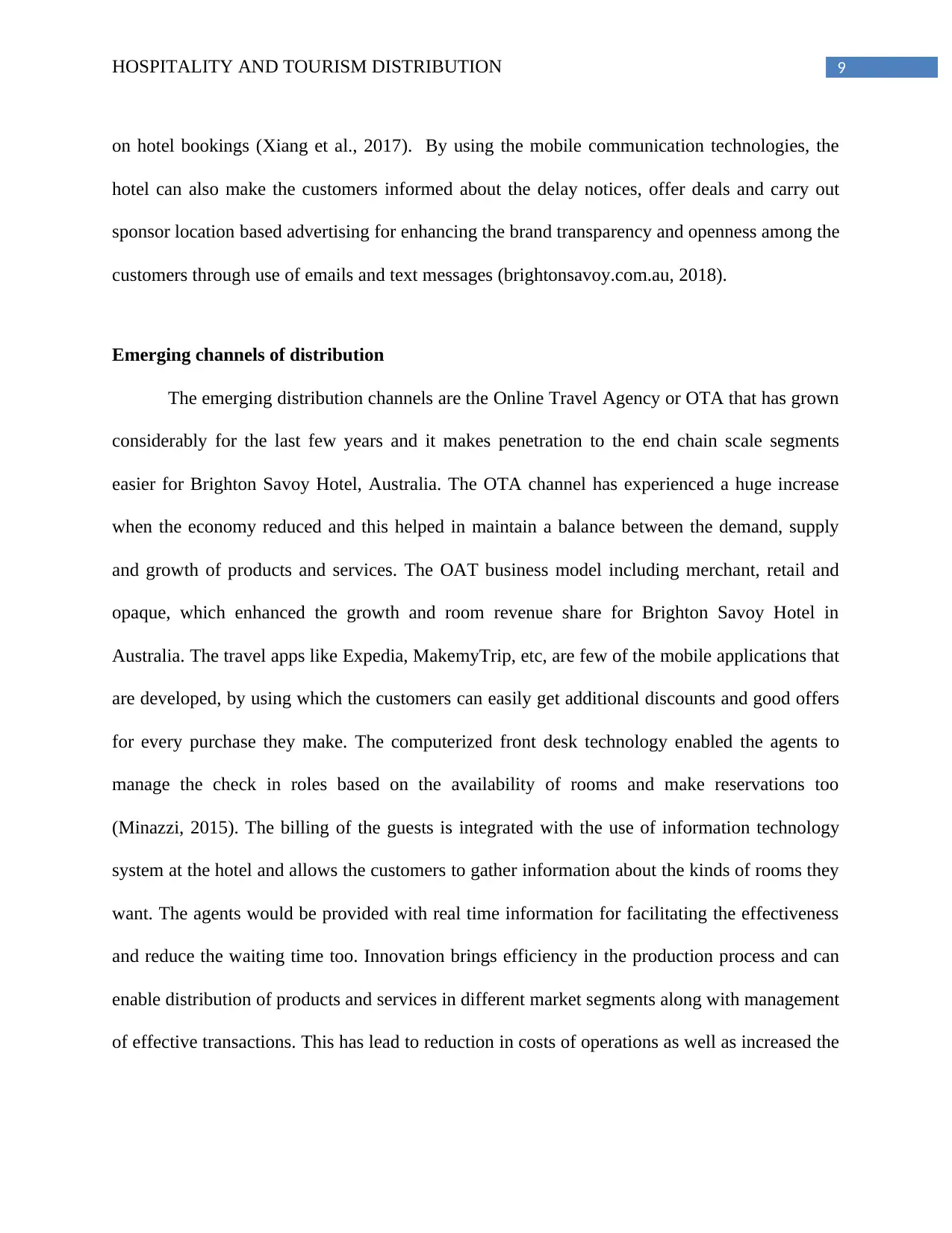
9HOSPITALITY AND TOURISM DISTRIBUTION
on hotel bookings (Xiang et al., 2017). By using the mobile communication technologies, the
hotel can also make the customers informed about the delay notices, offer deals and carry out
sponsor location based advertising for enhancing the brand transparency and openness among the
customers through use of emails and text messages (brightonsavoy.com.au, 2018).
Emerging channels of distribution
The emerging distribution channels are the Online Travel Agency or OTA that has grown
considerably for the last few years and it makes penetration to the end chain scale segments
easier for Brighton Savoy Hotel, Australia. The OTA channel has experienced a huge increase
when the economy reduced and this helped in maintain a balance between the demand, supply
and growth of products and services. The OAT business model including merchant, retail and
opaque, which enhanced the growth and room revenue share for Brighton Savoy Hotel in
Australia. The travel apps like Expedia, MakemyTrip, etc, are few of the mobile applications that
are developed, by using which the customers can easily get additional discounts and good offers
for every purchase they make. The computerized front desk technology enabled the agents to
manage the check in roles based on the availability of rooms and make reservations too
(Minazzi, 2015). The billing of the guests is integrated with the use of information technology
system at the hotel and allows the customers to gather information about the kinds of rooms they
want. The agents would be provided with real time information for facilitating the effectiveness
and reduce the waiting time too. Innovation brings efficiency in the production process and can
enable distribution of products and services in different market segments along with management
of effective transactions. This has lead to reduction in costs of operations as well as increased the
on hotel bookings (Xiang et al., 2017). By using the mobile communication technologies, the
hotel can also make the customers informed about the delay notices, offer deals and carry out
sponsor location based advertising for enhancing the brand transparency and openness among the
customers through use of emails and text messages (brightonsavoy.com.au, 2018).
Emerging channels of distribution
The emerging distribution channels are the Online Travel Agency or OTA that has grown
considerably for the last few years and it makes penetration to the end chain scale segments
easier for Brighton Savoy Hotel, Australia. The OTA channel has experienced a huge increase
when the economy reduced and this helped in maintain a balance between the demand, supply
and growth of products and services. The OAT business model including merchant, retail and
opaque, which enhanced the growth and room revenue share for Brighton Savoy Hotel in
Australia. The travel apps like Expedia, MakemyTrip, etc, are few of the mobile applications that
are developed, by using which the customers can easily get additional discounts and good offers
for every purchase they make. The computerized front desk technology enabled the agents to
manage the check in roles based on the availability of rooms and make reservations too
(Minazzi, 2015). The billing of the guests is integrated with the use of information technology
system at the hotel and allows the customers to gather information about the kinds of rooms they
want. The agents would be provided with real time information for facilitating the effectiveness
and reduce the waiting time too. Innovation brings efficiency in the production process and can
enable distribution of products and services in different market segments along with management
of effective transactions. This has lead to reduction in costs of operations as well as increased the
Paraphrase This Document
Need a fresh take? Get an instant paraphrase of this document with our AI Paraphraser
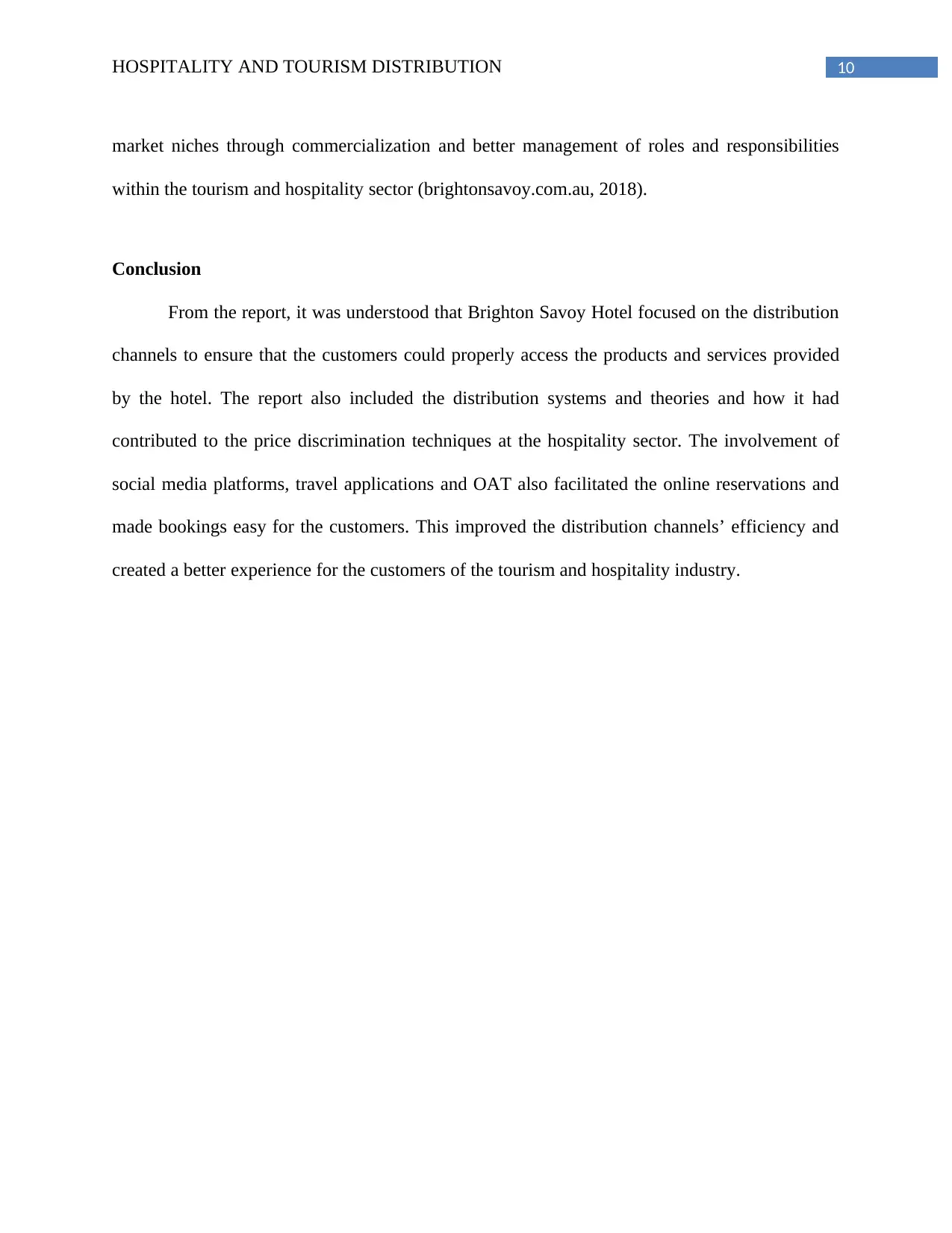
10HOSPITALITY AND TOURISM DISTRIBUTION
market niches through commercialization and better management of roles and responsibilities
within the tourism and hospitality sector (brightonsavoy.com.au, 2018).
Conclusion
From the report, it was understood that Brighton Savoy Hotel focused on the distribution
channels to ensure that the customers could properly access the products and services provided
by the hotel. The report also included the distribution systems and theories and how it had
contributed to the price discrimination techniques at the hospitality sector. The involvement of
social media platforms, travel applications and OAT also facilitated the online reservations and
made bookings easy for the customers. This improved the distribution channels’ efficiency and
created a better experience for the customers of the tourism and hospitality industry.
market niches through commercialization and better management of roles and responsibilities
within the tourism and hospitality sector (brightonsavoy.com.au, 2018).
Conclusion
From the report, it was understood that Brighton Savoy Hotel focused on the distribution
channels to ensure that the customers could properly access the products and services provided
by the hotel. The report also included the distribution systems and theories and how it had
contributed to the price discrimination techniques at the hospitality sector. The involvement of
social media platforms, travel applications and OAT also facilitated the online reservations and
made bookings easy for the customers. This improved the distribution channels’ efficiency and
created a better experience for the customers of the tourism and hospitality industry.
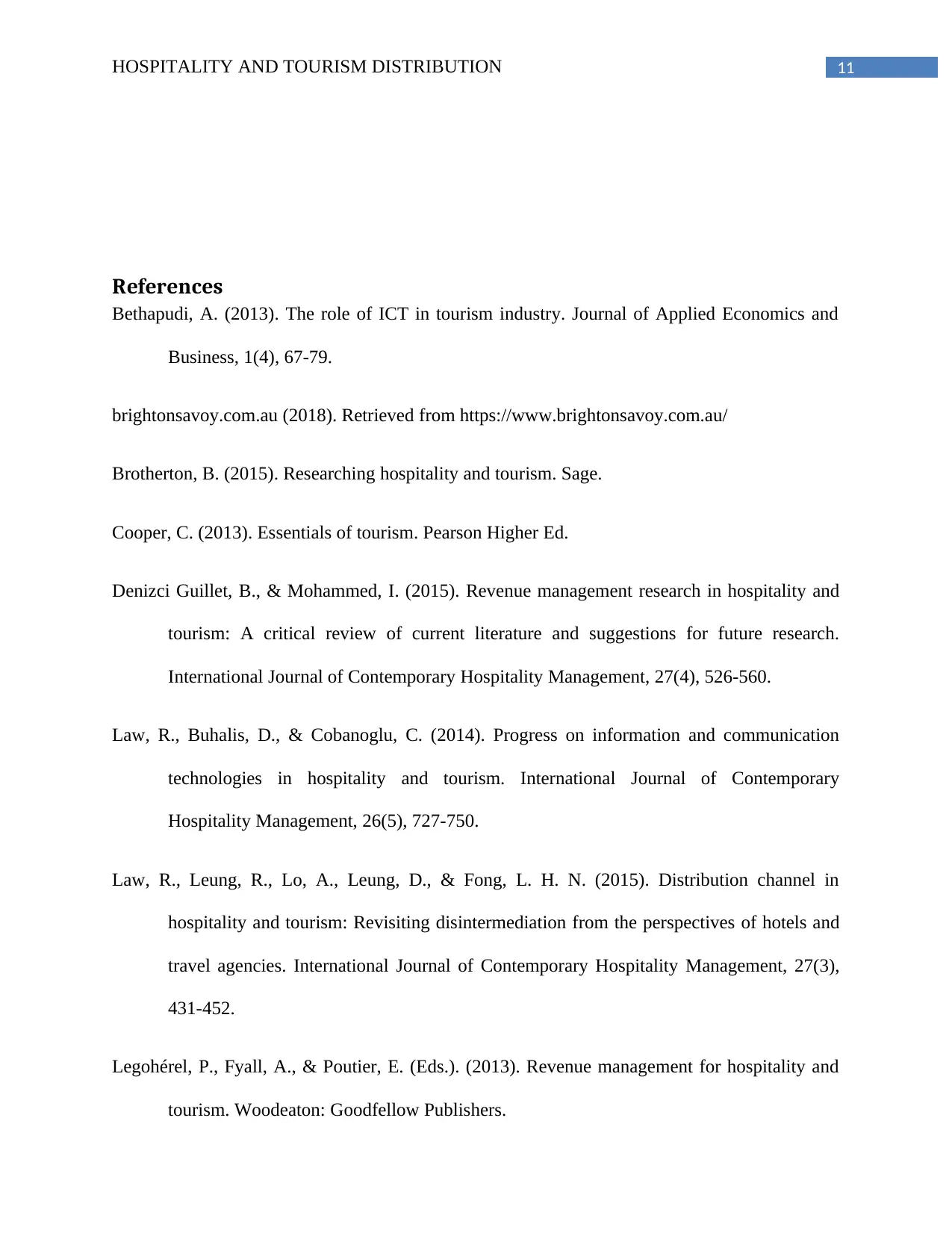
11HOSPITALITY AND TOURISM DISTRIBUTION
References
Bethapudi, A. (2013). The role of ICT in tourism industry. Journal of Applied Economics and
Business, 1(4), 67-79.
brightonsavoy.com.au (2018). Retrieved from https://www.brightonsavoy.com.au/
Brotherton, B. (2015). Researching hospitality and tourism. Sage.
Cooper, C. (2013). Essentials of tourism. Pearson Higher Ed.
Denizci Guillet, B., & Mohammed, I. (2015). Revenue management research in hospitality and
tourism: A critical review of current literature and suggestions for future research.
International Journal of Contemporary Hospitality Management, 27(4), 526-560.
Law, R., Buhalis, D., & Cobanoglu, C. (2014). Progress on information and communication
technologies in hospitality and tourism. International Journal of Contemporary
Hospitality Management, 26(5), 727-750.
Law, R., Leung, R., Lo, A., Leung, D., & Fong, L. H. N. (2015). Distribution channel in
hospitality and tourism: Revisiting disintermediation from the perspectives of hotels and
travel agencies. International Journal of Contemporary Hospitality Management, 27(3),
431-452.
Legohérel, P., Fyall, A., & Poutier, E. (Eds.). (2013). Revenue management for hospitality and
tourism. Woodeaton: Goodfellow Publishers.
References
Bethapudi, A. (2013). The role of ICT in tourism industry. Journal of Applied Economics and
Business, 1(4), 67-79.
brightonsavoy.com.au (2018). Retrieved from https://www.brightonsavoy.com.au/
Brotherton, B. (2015). Researching hospitality and tourism. Sage.
Cooper, C. (2013). Essentials of tourism. Pearson Higher Ed.
Denizci Guillet, B., & Mohammed, I. (2015). Revenue management research in hospitality and
tourism: A critical review of current literature and suggestions for future research.
International Journal of Contemporary Hospitality Management, 27(4), 526-560.
Law, R., Buhalis, D., & Cobanoglu, C. (2014). Progress on information and communication
technologies in hospitality and tourism. International Journal of Contemporary
Hospitality Management, 26(5), 727-750.
Law, R., Leung, R., Lo, A., Leung, D., & Fong, L. H. N. (2015). Distribution channel in
hospitality and tourism: Revisiting disintermediation from the perspectives of hotels and
travel agencies. International Journal of Contemporary Hospitality Management, 27(3),
431-452.
Legohérel, P., Fyall, A., & Poutier, E. (Eds.). (2013). Revenue management for hospitality and
tourism. Woodeaton: Goodfellow Publishers.
⊘ This is a preview!⊘
Do you want full access?
Subscribe today to unlock all pages.

Trusted by 1+ million students worldwide
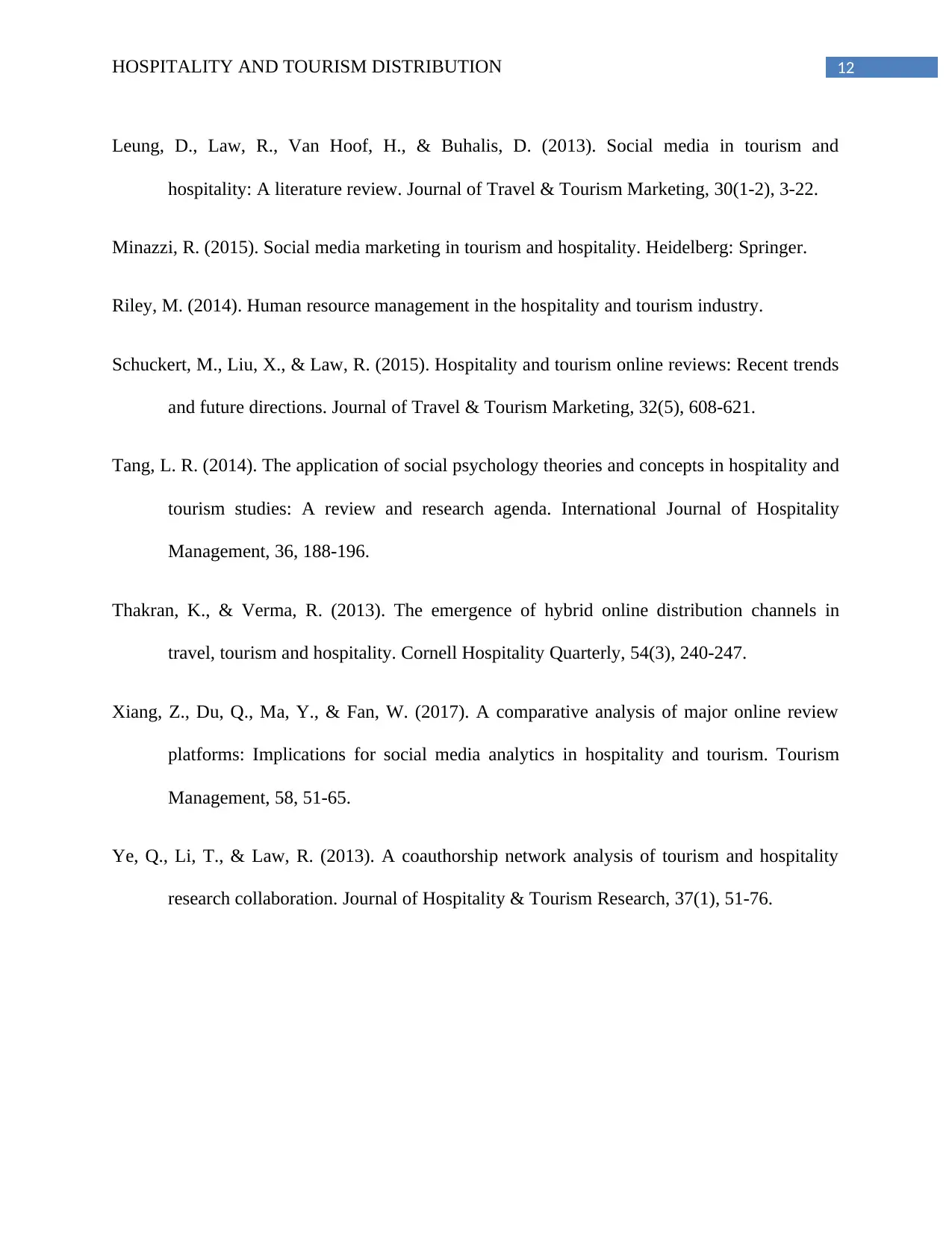
12HOSPITALITY AND TOURISM DISTRIBUTION
Leung, D., Law, R., Van Hoof, H., & Buhalis, D. (2013). Social media in tourism and
hospitality: A literature review. Journal of Travel & Tourism Marketing, 30(1-2), 3-22.
Minazzi, R. (2015). Social media marketing in tourism and hospitality. Heidelberg: Springer.
Riley, M. (2014). Human resource management in the hospitality and tourism industry.
Schuckert, M., Liu, X., & Law, R. (2015). Hospitality and tourism online reviews: Recent trends
and future directions. Journal of Travel & Tourism Marketing, 32(5), 608-621.
Tang, L. R. (2014). The application of social psychology theories and concepts in hospitality and
tourism studies: A review and research agenda. International Journal of Hospitality
Management, 36, 188-196.
Thakran, K., & Verma, R. (2013). The emergence of hybrid online distribution channels in
travel, tourism and hospitality. Cornell Hospitality Quarterly, 54(3), 240-247.
Xiang, Z., Du, Q., Ma, Y., & Fan, W. (2017). A comparative analysis of major online review
platforms: Implications for social media analytics in hospitality and tourism. Tourism
Management, 58, 51-65.
Ye, Q., Li, T., & Law, R. (2013). A coauthorship network analysis of tourism and hospitality
research collaboration. Journal of Hospitality & Tourism Research, 37(1), 51-76.
Leung, D., Law, R., Van Hoof, H., & Buhalis, D. (2013). Social media in tourism and
hospitality: A literature review. Journal of Travel & Tourism Marketing, 30(1-2), 3-22.
Minazzi, R. (2015). Social media marketing in tourism and hospitality. Heidelberg: Springer.
Riley, M. (2014). Human resource management in the hospitality and tourism industry.
Schuckert, M., Liu, X., & Law, R. (2015). Hospitality and tourism online reviews: Recent trends
and future directions. Journal of Travel & Tourism Marketing, 32(5), 608-621.
Tang, L. R. (2014). The application of social psychology theories and concepts in hospitality and
tourism studies: A review and research agenda. International Journal of Hospitality
Management, 36, 188-196.
Thakran, K., & Verma, R. (2013). The emergence of hybrid online distribution channels in
travel, tourism and hospitality. Cornell Hospitality Quarterly, 54(3), 240-247.
Xiang, Z., Du, Q., Ma, Y., & Fan, W. (2017). A comparative analysis of major online review
platforms: Implications for social media analytics in hospitality and tourism. Tourism
Management, 58, 51-65.
Ye, Q., Li, T., & Law, R. (2013). A coauthorship network analysis of tourism and hospitality
research collaboration. Journal of Hospitality & Tourism Research, 37(1), 51-76.
1 out of 13